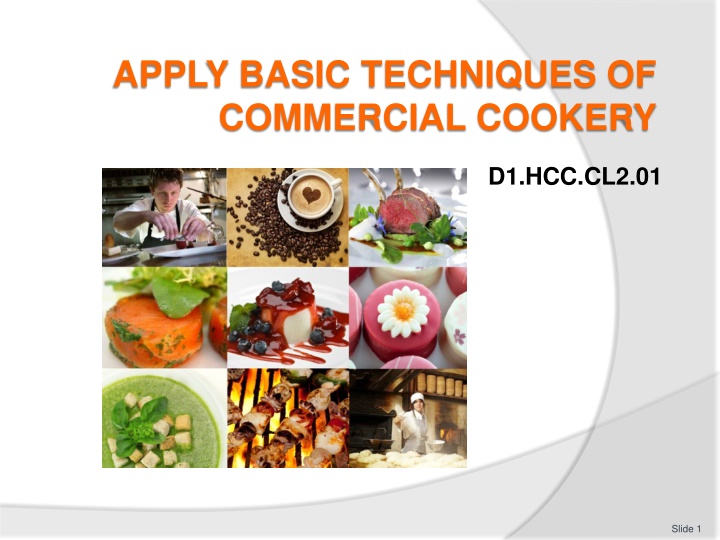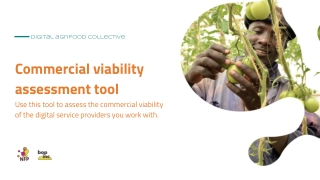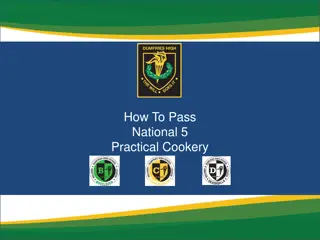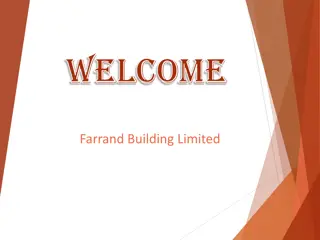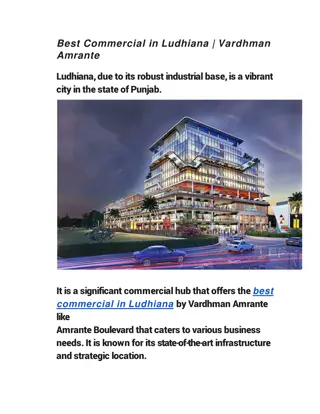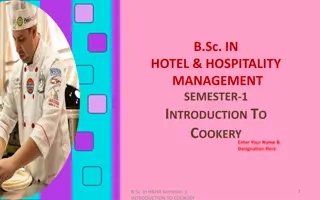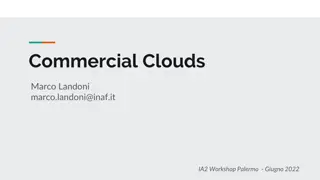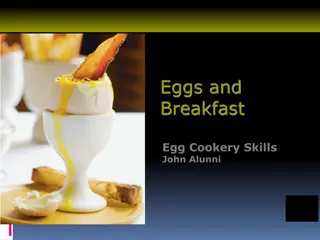APPLY BASIC TECHNIQUES OF COMMERCIAL COOKERY
Explore the essential techniques of commercial cookery including selecting and using equipment, wet and dry cooking methods, and assessment criteria. Learn about standard recipes, equipment categories, and the importance of quality food preparation skills. This comprehensive guide covers everything from equipment selection to practical application in a commercial kitchen setting.
Download Presentation

Please find below an Image/Link to download the presentation.
The content on the website is provided AS IS for your information and personal use only. It may not be sold, licensed, or shared on other websites without obtaining consent from the author.If you encounter any issues during the download, it is possible that the publisher has removed the file from their server.
You are allowed to download the files provided on this website for personal or commercial use, subject to the condition that they are used lawfully. All files are the property of their respective owners.
The content on the website is provided AS IS for your information and personal use only. It may not be sold, licensed, or shared on other websites without obtaining consent from the author.
E N D
Presentation Transcript
APPLY BASIC TECHNIQUES OF COMMERCIAL COOKERY D1.HCC.CL2.01 Slide 1
Apply basic techniques of commercial cookery This unit comprises three Elements: Select and use equipment Apply wet methods of cookery Apply dry methods of cookery Slide 2
Assessment Assessment for this unit may include: Oral questions Written questions Work projects Workplace observation of practical skills Practical exercises Slide 3
Introduction The basic techniques of commercial cookery underpin quality food preparation For each of the basic techniques you need to have a sound understanding of the: Definition Principles Foods that are suitable Appropriate equipment Common problems Slide 4
Element 1: Select and use equipment Slide 5
Large equipment Large equipment is usually fitted and permanently attached to a power source. It may also be large free standing equipment. This includes: Stoves: Electric, gas or induction Ovens: Electric, gas, convection or combination Grills: Flattop, Char, Salamander Deep fryers Slide 6
Small equipment Small equipment in the commercial kitchen includes: Small electrical equipment: Mixers, blenders, liquidisers, vitamisers, stick blenders, food processors Measuring equipment: Scales, jugs, cups, spoons, thermometers, timers Preparation equipment: Bowls, whisks, pestle and mortar, rolling pins, mallet, strainers, colanders, Chinois, saucepans, pots Serving equipment: Tongs, spatulas, ladles Slide 7
Standard recipes Recipes used in the commercial environment are referred to as standard recipes. They are written in a standard format specific to the establishment. This improves efficiency and consistency in food production. Besides ingredients, quantities and cooking methods standard recipes include the: Cost of the recipe: Which allows the cost and selling price of the dish to be calculate Equipment required to make the dish Presentation of the final dish Slide 8
Environmental sustainability Commercial kitchens use large amounts of energy to operate and maintain equipment. Consider how you can save energy in the workplace: Turning gas and electricity on or off as needed Using the right sized equipment Using lids on pots if appropriate Keeping doors closed Maintaining: Seals on ovens, refrigerators and freezers Thermostats Slide 9
Use equipment in a safe manner according to manufacturer s and enterprise procedures Commercial equipment can be hazardous if not used correctly and in a safe manner. Consider the dangers of: Electrical and gas equipment Sharp knives and blades Additionally the kitchen environment can be a hazardous place when using equipment. Consider the dangers of: Slippery floors Heavy lifting Extremes of heat Chemicals Slide 10
Personal protective equipment When working in a commercial kitchen you will often be provided with personal protective equipment. This is referred to as PPE. Learn how to use it correctly. Types of PPE include: Cooks uniform: Especially designed to protect against heat and spills Gloves: Types designed to protect against heat, chemicals, bacteria, cuts and skin irritation Eye protection Face mask Slide 11
Equipment safety Each type of equipment has potential risks. Be aware of the risks and always practice safety procedures when using: Electrical and gas equipment Knives Steamers Slicers Slide 12
Hygiene procedures Safe equipment handling includes food safety elements such as: Cleaning and sanitising Equipment Surfaces Slide 13
Clean and store equipment as appropriate to enterprise procedures All food and surfaces in the kitchen have microorganisms or bacteria present. Cleaning and sanitising equipment aims to: Prevent cross contamination Minimise the levels of bacteria to prevent food poisoning Slide 14
Equipment cleaning Kitchens need to have a well organised system for cleaning. Cleaning schedules include: What is cleaned and how frequently Who is responsible for the cleaning How the cleaning is to be carried out, including: Cleaning equipment Cleaning chemicals Cleaning description sheets should be used for all major pieces of equipment. Slide 15
Cleaning and sanitising Cleaning and sanitising are not the same! Cleaning means physically removing dirt, residues and food particles Sanitising means killing the microorganisms on the surface of the equipment It is not one or the other but both that ensures food preparation equipment if hygienic. Wiping is not a substitute for cleaning or sanitising. It merely spreads the microorganisms across the surface. Slide 16
Cleaning and sanitising The standard procedure for cleaning equipment is as follows: Remove visible food residues by scraping or pre cleaning Wash using detergent and hot water Rinse Sanitise Air dry Most equipment will need to be hand washed but some small equipment can be washed in the commercial dishwasher. Slide 17
Equipment storage Clean equipment needs to be stored appropriately so that: Contamination is minimised: Usually under the bench in containers or draws It is easy and safe to access Occupational, health and safety factors are taken into account: Heavy items should be stacked low on shelves Reaching over hot stoves and flames is not required Stacked evenly and not too high so it doesn t fall It is not damaged or broken Slide 18
Equipment maintenance Equipment needs to be well maintained. Kitchens should have a written maintenance schedule to assist the staff to regularly check equipment. The establishment procedures or manufacturers instructions should be followed for maintain equipment in good working order. All equipment both small and large needs to be safely maintained, including: Calibrating ovens and thermometers Sharpening knives and blades on slices and mandolins Slide 19
Element 2: Apply wet methods of cookery Slide 20
Heat transfer Heat transfer occurs: Within foods In the medium in which foods are cooked Via the energy source used for cooking Heat transfer methods: Conduction Convection Radiation Slide 21
Methods of cookery Food is cooked to make it more palatable. The palatability of food is judged by a range of factors including: Texture Smell Colour Flavour The basic methods of cookery are divided into two groupings, these are: Wet methods of cookery Dry methods of cookery Slide 22
Select appropriate wet cookery method for preparation of the dish/s The basic methods of wet cookery are: Boiling Poaching Steaming Stewing Braising Slide 23
Boiling Boiling is: Subjection of food to heat totally submerged in a liquid at 100 C Gentle boiling water is referred to as simmering, this 95 C - 98 C Food is boiled to tenderise and make it more palatable and digestible. Boiling also changes the muscular or fibre tissues and accentuates the flavour. Slide 24
Principles of boiling Principles: The item must be completely covered in liquid Salted meat and root vegetables must be started in cold water Green vegetables must be started in boiling water and be uncovered while cooking to retain colour Scum that rises must be removed by skimming Sauces and soups should be simmered Stocks should be simmered to prevent them becoming cloudy Fish is unsuitable for boiling as it tends to break up Slide 25
Blanching Blanching: Blanching is the process of partly cooking food for later use by immersing in a hot liquid to: Remove the bitter taste from many vegetables Seal the product Partly cook food to speed up the cooking time Assist in removing the skin from some foods, i.e. tomatoes Blanching is often a preliminary process to other cooking principles such as saut ing, braising or deep frying Slide 26
Blanching and refreshing Blanching can be done in either hot or cold water: Cold water to open cells, remove blood, impurities and to leach out strong tastes and salt from salted meats Hot water to seal in flavours and juices, partly pre- cook foods and to assist in the removal of skins e.g. tomatoes and peaches Blanching can also be hot fat at 150 C Refreshing is when hot blanched food is plunged into cold water to stop the cooking process Slide 27
Poaching Poaching is: Subjection of food to heat in a liquid held as close to boiling point as possible without movement of the liquid Temperature for poaching is 93 C to 95 C Food is poached: To prevent fragile foods falling apart as when boiled To keep the food moist and tender As a nutritious way to cook (requiring no added fat), with food retaining natural flavour As aromatics can also be added to the poaching liquid adding flavour to foods Slide 28
Poaching Principles: Item must be completely covered in the liquid Start process by bringing liquid to the boil, then reduce heat to poaching temperature before adding the food Whole large fish start in cold liquid to allow for even cooking Small fish and fish cuts start at poaching temperature For poaching eggs allow enough liquid for the egg to float freely Fruit is poached in sugar syrup. It must be completely covered in liquid and covered Slide 29
Steaming Definition: Subjection of food to heat in the form of steam in enclosed or confined space Pressure varies according to the type of equipment used: Atmospheric steaming 103 C Pressure steaming 121 C Slide 30
Why is food is steamed? Food is steamed because: It is a very quick method of cookery, approximately twice as quick as boiling It retains the colour, flavour and nutritional value of food It s a fat free method of cookery Steaming does not greatly enhance the flavour of a dish. Slide 31
Principles of steaming Principles: The foods that are suitable for steaming vary: Atmospheric steaming is suitable for tender items of food Pressure steaming is suitable for tough cuts of food The steamer must be tightly closed or lidded Puddings in basins must be covered with greaseproof paper The steamer must be hot before placing food in Slide 32
Stewing Definition: Stewing is the subjection of food to the action of heat in a minimum amount of simmering liquid or sauce Principles: The food item must be covered with liquid Foods to be simmered slowly to tenderise the meat and concentrate the flavours Suitable for tough items of food Item and cooking liquid are served together Meat for stews can be either seared in hot fat first (e.g. ragout) or left natural (e.g. Irish stew) Slide 33
Braising Definition: Braising is the subjection of food to the action of heat in an oven, while it is enclosed in a container with liquid or sauce Braising is used to: Tenderise food items of a tough nature Combine foods to create flavoursome dishes Slide 34
Braising Principles Food items to be braised should be of a tough nature Most foods must be sealed before braising Braising pan should be in keeping with the size of the item being braised Items must be half covered with liquid Container must be tightly lidded to stop evaporation Process carried out slowly to tenderise tough meats Liquid may be used to produce a sauce Braised vegetables may be served with a sauce made separately: the liquid is usually too strong and similar in taste to the vegetables
Apply appropriate wet cooking method of preparation of the dish Each of the methods of cookery lends itself to particular types of foods: Make sure the methods of cookery selected are appropriate for the foods being prepared You also need to apply: The specifics of these selected methods of cookery The associated preparation techniques for each method of cookery Slide 36
Types of foods Appropriate foods for: Boiling: Pasta, rice, tough cuts of meat, poultry, eggs in the shell, root vegetables, tubers, green vegetables and legumes Stock and soups Poaching: Seafood, chicken, beef fillet, fruit Steaming: Seafood, chicken, rice and vegetables Puddings and dumplings Slide 37
Types of foods Appropriate foods for: Braising: Tough cuts of meat, whole fish, root and fibrous vegetables Stewing: Tough cuts of meat, some fish and shellfish, fruit, root and fibrous vegetables Slide 38
Associated preparation methods Boiling: Soaking, skimming and refreshing Poaching: Submerging, draining and reducing poaching liquids Steaming: Molding and wrapping Braising: Browning Slide 39
Appropriate equipment Identify correct equipment: Equipment for storage of raw ingredients Equipment for preparation and processing Equipment for cooking Equipment for hot or cold holding Slide 40
Identify and solve problems in the application of the cooking method When cooking foods using the wet methods of cookery you are likely to encounter common problems such as: Overcooked foods Tough meats Soggy dishes Sauces too dry or too wet Slide 41
Products Understanding the products that are being used will assist to improve skills: Meats are animal muscle tissue: Meat from older animals is tougher than from younger animals Muscle tissue develops with use so muscles that are used more are tougher Slide 42
Portion control Portion control should be applied throughout the food preparation process. Portion Control includes: Using standard recipes Preparing foods consistently Serving foods consistently Slide 43
Problems wet cooking methods What are the common problems that occur when: Boiling: Simmering Poaching Steaming Stewing Braising Identify these problems and seek solutions to remedy them. Slide 44
Improving standard recipes Standard recipes should be refined as you go. Changes may need to be made to: Timing Equipment Ingredients Techniques Portion sizes Slide 45
Continuous improvement Cooking skills take time to learn Evaluation of your skills will assist you to improve Slide 46
Coordinate the production of menu items Many elements combine to produce meals to meet the expectations of customers, including: The selection of menu and service styles The preparation and cooking of foods Slide 47
Menu and service styles Menu and service styles impact on types of cooking methods. Consider the appropriate wet cooking methods for the following services: A la carte Table d'h te Buffet Cocktail Slide 48
Storage capacity Food needs to be stored during the various stages of food production. Storage requirements need to be considered during: Food preparation Cooking Service Slide 49
Cooking systems Cooking systems used in commercial kitchens for the wet methods of cookery: The most common is: Cook and serve Alternatives to cook and serve include: Cook/chill Cook/freeze Sous vide Slide 50
